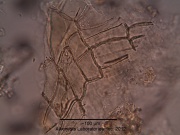Angelica sinensis (root)
m |
|||
| Line 10: | Line 10: | ||
=Microscopic Entries= | =Microscopic Entries= | ||
| − | {{Microscopy | source=Elan M. Sudberg, Alkemist Laboratories | + | {{Microscopy | source=Elan M. Sudberg, Alkemist Laboratories |
| companyimage= AP-LOGO-Laboratories Crop - Copy.jpg | | companyimage= AP-LOGO-Laboratories Crop - Copy.jpg | ||
| companyURL=http://www.Alkemist.com | | companyURL=http://www.Alkemist.com | ||
| Line 19: | Line 19: | ||
| caption2=Scalariform vessel in longitudinal view of Angelica sinensis viewed at 400x with Acidified Chloral Hydrate. | | caption2=Scalariform vessel in longitudinal view of Angelica sinensis viewed at 400x with Acidified Chloral Hydrate. | ||
| characteristics=cellular structures identified in Angelica sinensis are the brown oddly shaped cork and the scalariform vessel in longitudinal view when observed at 400x magnification with Acidified Chloral Hydrate. | | characteristics=cellular structures identified in Angelica sinensis are the brown oddly shaped cork and the scalariform vessel in longitudinal view when observed at 400x magnification with Acidified Chloral Hydrate. | ||
| + | | reference=British Pharmacopoeia, 2011 | ||
| }} | | }} | ||
=HPTLC Entries= | =HPTLC Entries= | ||
=Other Points of Interest= | =Other Points of Interest= | ||
Revision as of 04:45, 3 October 2012
Contents |
Introduction
Introduction from Wikipedia, the free encyclopedia (http://en.wikipedia.org/wiki/Angelica_sinensis, retrieved 02/20/2012).
Angelica sinensis, commonly known as "dong quai" or "female ginseng" is a herb from the family Apiaceae, indigenous to China.
Its dried root is commonly known in Chinese as Radix Angelicae Sinensis, or Chinese angelica (simplified Chinese: 当归; traditional Chinese: 當歸; pinyin: dāngguī; Pe̍h-ōe-jī: tong-kui) and is widely used in Chinese traditional medicine to treat gynecological ailments, fatigue, mild anemia and high blood pressure. It has analgesic, anti-inflammatory, antispasmodic and sedative effects. The plant's phytochemicals consist of coumarins, phytosterols, polysaccharides, ferulate, and flavonoids. It has antioxidant activity.
The quoted text in this section was licensed for use under the Creative Commons ShareAlike License, version 3.0: http://creativecommons.org/licenses/by-sa/3.0/
Macroscopic Entries
Microscopic Entries
|
HPTLC Entries
Other Points of Interest
Cite error: <ref> tags exist, but no <references/> tag was found

